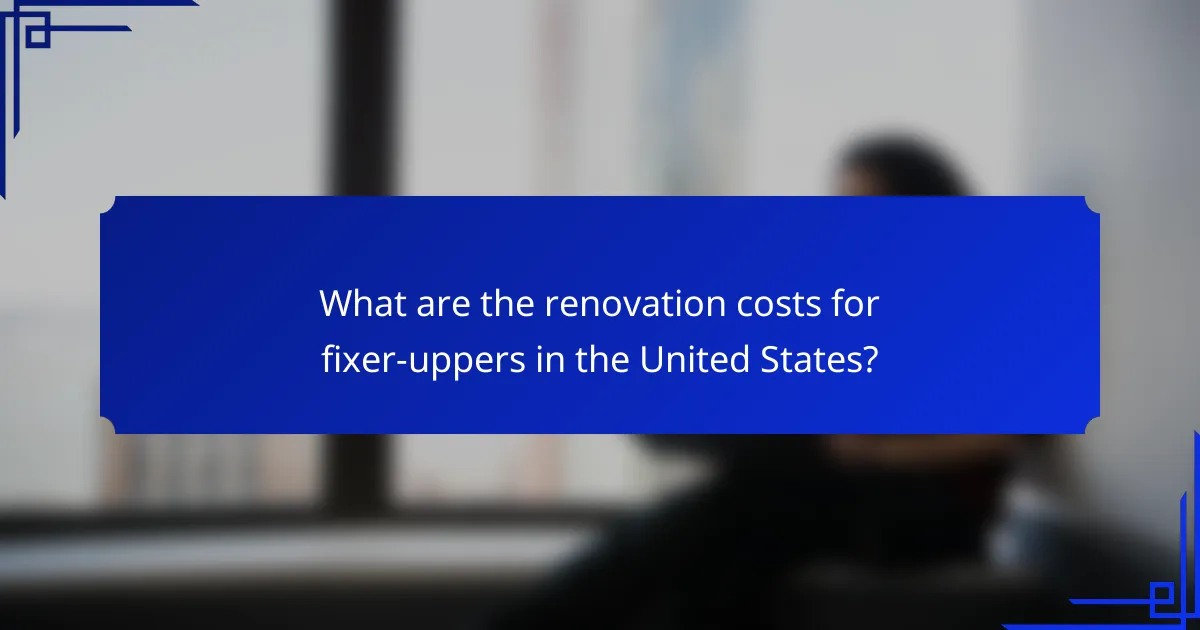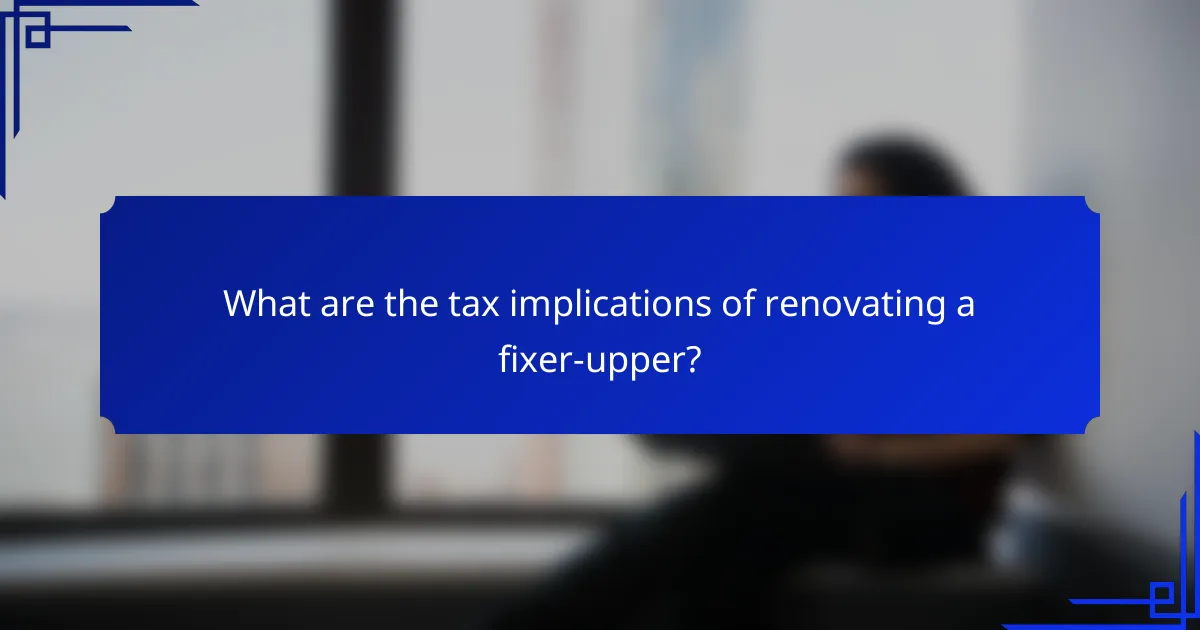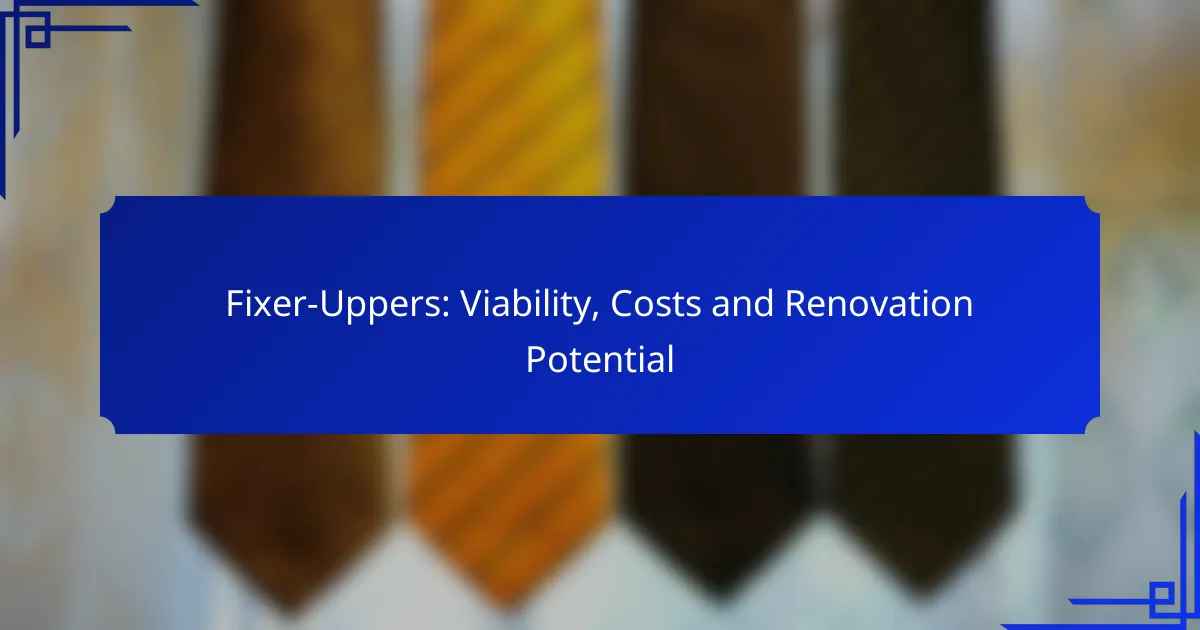Investing in a fixer-upper can be a rewarding venture, but it requires careful consideration of renovation costs and potential. With expenses ranging from $100 to $300 per square foot, evaluating the property’s location, structural integrity, and your budget is crucial for determining its viability. By focusing on high-return projects and balancing DIY efforts with professional help, homeowners can maximize their investment while minimizing costs.

What are the renovation costs for fixer-uppers in the United States?
Renovation costs for fixer-uppers in the United States can vary significantly based on location, project scope, and materials. On average, homeowners can expect to spend anywhere from $100 to $300 per square foot for renovations, depending on the complexity of the work involved.
Average renovation cost per square foot
The average renovation cost per square foot typically ranges from $100 to $300. Basic cosmetic updates like painting and flooring may fall on the lower end, while extensive structural changes or high-end finishes can push costs to the higher end. Regional differences also play a significant role, with urban areas often experiencing higher costs than rural locations.
Cost breakdown by project type
When assessing renovation costs, it’s essential to consider the type of project. For example, kitchen remodels can range from $15,000 to $50,000, while bathroom renovations might cost between $10,000 and $25,000. Structural repairs, such as roof replacements or foundation work, can be more expensive, often exceeding $20,000.
Here’s a quick breakdown of common renovation projects and their average costs:
- Kitchen remodel: $15,000 – $50,000
- Bathroom renovation: $10,000 – $25,000
- Roof replacement: $5,000 – $15,000
- Foundation repair: $10,000 – $30,000
Financing options for renovations
Homeowners have several financing options for renovations, including personal loans, home equity loans, and government-backed loans like FHA 203(k) loans. Personal loans may offer quick access to funds but often come with higher interest rates.
Home equity loans allow homeowners to borrow against the equity in their home, typically at lower interest rates. FHA 203(k) loans are specifically designed for home renovations, allowing buyers to finance both the purchase and the renovation costs in one mortgage.

How to assess the viability of a fixer-upper?
To assess the viability of a fixer-upper, evaluate its potential for renovation against the costs involved. Consider the property’s location, structural integrity, and your budget for repairs to determine if it’s a worthwhile investment.
Key factors to consider
Location is crucial when assessing a fixer-upper. Properties in desirable neighborhoods often appreciate more quickly, making them a better investment despite higher initial costs. Additionally, consider the local real estate market trends, as they can influence your potential return on investment.
Structural integrity is another key factor. Inspect the foundation, roof, plumbing, and electrical systems, as major repairs in these areas can significantly increase renovation costs. A property that requires only cosmetic updates may be more viable than one needing extensive structural work.
Inspection checklist for potential buyers
Before purchasing a fixer-upper, conduct a thorough inspection. Start with a checklist that includes key areas such as the roof condition, plumbing systems, electrical wiring, and foundation stability. Each of these can carry substantial repair costs if issues are found.
- Roof: Check for missing shingles or leaks.
- Plumbing: Look for water damage or outdated pipes.
- Electrical: Ensure the system meets current safety standards.
- Foundation: Look for cracks or signs of settling.
Additionally, consider hiring a professional inspector to uncover hidden problems that may not be immediately visible. This investment can save you from unexpected expenses down the line.

What are the best renovation strategies for fixer-uppers?
The best renovation strategies for fixer-uppers focus on maximizing value while minimizing costs. Prioritizing high-return projects and deciding between DIY efforts and hiring professionals are key to successful renovations.
High ROI renovations
High ROI renovations are improvements that significantly increase a property’s value relative to their cost. Common projects include kitchen remodels, bathroom upgrades, and energy-efficient installations, which can yield returns of 70% to 90% or more.
For example, a minor kitchen remodel might cost around $15,000 but could increase the home’s value by $20,000. Similarly, adding energy-efficient windows can lower utility bills and appeal to eco-conscious buyers, enhancing overall property value.
DIY vs. hiring professionals
Deciding between DIY renovations and hiring professionals depends on your skills, available time, and the project’s complexity. DIY can save money but may lead to costly mistakes if you’re inexperienced.
For straightforward tasks like painting or landscaping, DIY is often feasible. However, for complex projects like electrical work or structural changes, hiring licensed professionals is advisable to ensure safety and compliance with local regulations.

What are the common pitfalls when buying fixer-uppers?
Common pitfalls when buying fixer-uppers include overestimating the budget and underestimating the time required for renovations. These miscalculations can lead to financial strain and project delays, making it essential for buyers to approach such investments with a realistic perspective.
Overestimating budget
Many buyers fall into the trap of overestimating their budget for a fixer-upper. They often assume that renovation costs will be lower than they actually are, leading to financial shortfalls. It’s crucial to conduct thorough research and obtain multiple quotes from contractors to create a more accurate budget.
Consider including a contingency fund of around 10-20% of your total renovation budget to cover unexpected expenses. This can help mitigate the risk of running out of funds mid-project, which is a common issue for many homeowners.
Underestimating time required
Underestimating the time required for renovations is another frequent mistake. Many buyers expect quick turnarounds, but projects can often take much longer due to unforeseen issues or delays in obtaining permits. It’s wise to build a realistic timeline that accounts for potential setbacks.
To better manage expectations, consider breaking the project into phases and setting deadlines for each phase. This approach can help keep the renovation on track and provide a clearer picture of the overall timeline, reducing frustration and stress during the process.

How do local real estate markets affect fixer-upper investments?
Local real estate markets significantly influence the viability and profitability of fixer-upper investments. Factors such as demand, property values, and renovation costs vary by location, impacting potential returns on investment.
Market trends in urban areas
Urban areas often experience higher demand for housing, which can drive up property values and renovation costs. Investors should monitor trends such as population growth and job opportunities, as these can indicate future appreciation in property values.
In cities, fixer-uppers can yield substantial returns, especially if they are located in desirable neighborhoods. However, competition can be fierce, and investors may need to act quickly to secure properties at reasonable prices.
Impact of neighborhood development
Neighborhood development plays a crucial role in the success of fixer-upper investments. Areas undergoing revitalization or infrastructure improvements tend to attract more buyers, increasing property values and rental demand.
Investors should research upcoming projects, such as new schools, parks, or transit options, as these can enhance the appeal of a fixer-upper. However, it’s essential to consider the timeline of these developments, as immediate returns may not be guaranteed.

What financing options are available for fixer-upper projects?
Several financing options exist for fixer-upper projects, allowing homeowners to fund renovations and repairs. These options include specialized loans and lines of credit that cater specifically to properties needing significant work.
FHA 203(k) loans
The FHA 203(k) loan is a government-backed mortgage designed for homes that require repairs or renovations. This loan allows buyers to finance both the purchase price and the renovation costs into a single mortgage, making it easier to manage finances.
To qualify, the property must meet certain standards, and the renovation costs typically need to be at least a few thousand dollars. Borrowers can access funds for a variety of improvements, from structural repairs to cosmetic upgrades.
Home equity loans
Home equity loans allow homeowners to borrow against the equity they have built in their property. This type of financing can be a practical option for funding renovations on a fixer-upper, as it often comes with lower interest rates compared to personal loans.
Homeowners should consider the amount of equity they have, as lenders typically allow borrowing up to a certain percentage of the home’s value. It’s important to ensure that the additional debt aligns with the overall renovation budget to avoid financial strain.

What are the tax implications of renovating a fixer-upper?
Renovating a fixer-upper can have various tax implications, including potential deductions and capital gains considerations. Understanding these factors is crucial for maximizing financial benefits and avoiding unexpected liabilities.
Tax deductions for home improvements
Home improvements that enhance the value of a property may qualify for tax deductions. Generally, repairs that maintain the property, such as fixing a roof or replacing a furnace, are not deductible, while improvements that add value, like a new kitchen or bathroom, can be included in the cost basis of the home.
It’s essential to keep detailed records of all renovation expenses, as these can be used to adjust the home’s basis when selling. This can ultimately reduce the taxable gain on the sale of the property.
Capital gains tax considerations
When selling a renovated fixer-upper, capital gains tax may apply to the profit made from the sale. Homeowners can exclude up to $250,000 of capital gains ($500,000 for married couples) if they have lived in the home for at least two of the last five years.
However, if the renovations significantly increase the home’s value, the adjusted basis will be higher, potentially lowering the taxable gain. It’s advisable to consult a tax professional to navigate these complexities and ensure compliance with local tax regulations.
